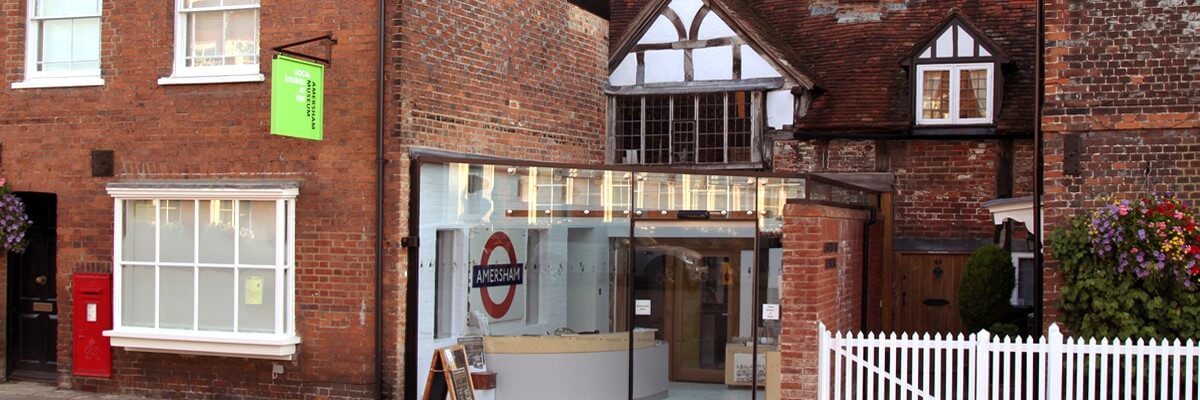
Information from the soon to be published book The Rabbi in the Green Jacket: Memories of Jewish Buckinghamshire 1939-1945 by Vivien and Deborah Samson. Please note permission for other use of this material and photographs, must be sought from the co-authors, who retain all rights.
The book was published by Matador in November 2015 (cost £12.99 plus postage and packaging). For more information or to order a copy use your search engine to find The Rabbi in the Green Jacket.
There have been a few Jewish families living in Buckinghamshire for generations, but the Second World War saw an influx of British-born Jewish evacuees and European Jewish refugees who came to Amersham and the surrounding villages to escape the bombs, all seeking a place of safety within the Chiltern Hills. Many domestic servants living locally at the time were Jewish as this was one way of getting a visa into Britain in order to escape Nazi-occupied Europe.
This increased population joined the small numbers of pre-war Jewish residents in forming The Amersham Hebrew Congregation (1942 – 1968) which was loosely based on the (orthodox) United Synagogue. The consecration of the synagogue, a pre-fabricated hut located on Woodside Road, was on Sunday 23rd August 1942. Before this services were held in St Leonard’s Hall Chesham Bois or private homes. It was established by the United Synagogue Membership Group of Amersham and District.
A synagogue building is important to allow Jewish people to worship together, just as other religions have their sacred and spiritual space. It also functions as a community centre, a place where learning, socialising, charity and inter-faith education can take place. For people familiar with survival against persecution, a place of worship, with others who want a peaceful world, allows for a sense of identity, which might be denied in other places. The synagogue offers a supportive place of calm from a chaotic world. Religious people attend daily for prayers, others only for special occasions, perhaps more for cultural and social reasons. So at a time when Jewish people, religious or not, were being, chased out of their homes and countries, and being subjected to genocide, building a new synagogue was in part a statement of survival. The humble pre-fab that became the Amersham synagogue was also a symbol of hope. Importantly, the synagogue was a place of inclusion. The people of Amersham, and surrounding areas, regardless of their religion and beliefs were welcomed in to share in prayers, socials and public talks.
During the war years, three ministers were appointed; Reverend Sonnie M. Bloch, Rev. Izaak Rapaport PhD, (appointed 1941) who was also the secretary, and Rev. Jonah Indech (appointed 1st April 1944 – 31st December 1945). There was also an orthodox congregation based in Chesham, led by Rabbi J Ehrentreu.
For the Jewish evacuees and refugees arriving in Amersham there was the added fear that the Jewish people were the principal target of Nazi persecution. They were not only in Amersham escaping the Luftwaffe bombs, but they were hearing eye-witness accounts from the refugees of occupied Europe who had experienced first-hand the brutality of the Nazis. The Germans were closing in on Britain and there would be nowhere else to seek sanctuary. The Jewish people had to carry on, with a stiff upper lip, knowing that Judaism and their lives were in grave danger.
People who came as refugees had their homes, jobs, belongings and financial assets confiscated by the Nazis. Jewish refugees to the UK paid for their own health care as did all British citizens. There was no welfare state. For those who struggled, support was generated mainly through Jewish charities and the British Quaker Society. To ensure refugees entering this island would blend in, and not be a burden, each new arrival was given rules from the Board of Deputies of British Jews with strict instructions on how to behave in a British manner, and so they did.
Many local Jews were, or became, highly distinguished in their respective fields. Maurice Edelman, who lived in Clifton Road, Chesham Bois was the author of several books, the war-correspondent for the Picture Post and the Labour MP for Coventry from 1945 until his death in 1975. Sir Michael Sobell, the industrialist and philanthropist moved his business to Amersham (which provided electrical equipment to the armed forces) when his factory in London was bombed. [Editor’s note: the Sobell factory was off Plantation Road, where the Halstan printing business is now.] Composer Alexander Goehr spent the war years in Amersham after his family left Berlin in 1932 when he was a few months old.
Marie-Louise von Motesiczky, one of Austria’s most important 20th century painters, from a distinguished Viennese family, lived in Chesham Bois probably with Father Milburn, whom she painted, and his wife at Durris, Stubbs Wood. She bought a large house ‘Cornerways’ in Chestnut Lane with her mother where she lived to the end of the war before returning to London. Although she returned often to Amersham as her mother stayed here. She persuaded her lover, Elias Canetti, to follow her to Chesham Bois. Canetti, who won the Nobel Prize for literature in 1981, lived at Durris with his wife Veza and wrote about his time in the area in his memoirs “Party in the Blitz”.
Members of the Jewish Community at the time were well integrated in the district and served on numerous committees. They gave to charity, concerned themselves with the needs of the long-term Amersham residents and contributed to the war effort in many ways. They served as air raid wardens and firewatchers. They were active members of the Women’s Voluntary Service (WVS), volunteered at Amersham Hospital and made barrage balloons at The Maltings amongst other things.
There were also many Jewish servicemen from the Allied forces (including German, Polish, Palestinian and American servicemen) stationed in the area at army camps, Bovingdon Air Force Base or working for British Intelligence at Latimer House. The Amersham community provided them with a social club and kosher canteen and invited them into their homes for Pesach, Shabbat and the High holydays.

Sergeant Harry Kleiner, RAFVR 57 Squadron, born in Wandsworth in 1913, was the son of Joseph and Esther Kleiner of Dorset House, Long Park, Chesham Bois who were both active members of the Amersham Jewish Community. He was the flight engineer on a Lancaster bomber, targeting the city of Dortmund when it was shot down over the North Sea 40 km west of the Dutch coastal town of Egmond aan Zee 25th May 1943. Sgt Harry Kleiner is now buried in Leeuwarden Jewish Cemetery but he is commemorated on the Chesham Bois War Memorial.
Henry Amar told us his childhood memories:
Whilst many families returned to London after the war some settled in the area and are able to tell us their memories of that period. Henry moved to Little Chalfont in 1939 when he was 1 year old. He remembers his own contribution to the War Effort as some very poor knitting for the Navy “pity the poor sailor who got my effort” and collecting silver paper from the area around his school. A German plane had dropped silver paper all over the area and Henry understood that this was so German bombers flying at night might be helped to target Statters Switchgear in Little Chalfont who made parts for the RAF. All the children from his school were sent out to collect the silver paper.
His father built a brick shelter in the garden and Henry remembers them all laughing at his Granddad running to the shelter with a metal pudding bowl on his head! He saw the V1 rocket passing over on its way to Chesham Bois and his uncle, home on leave, shouted at him to get indoors.
After the war the local Jewish community grew smaller but lifetime friendships had been made. The Levy family also lived in Little Chalfont during the war years. They returned to live in North London but their son Brian is Henry Amar’s best friend today.
Tour of Jewish Amersham
Click here for a pdf copy of the walk (four pages without the pictures) if you prefer a paper copy.
Welcome to the story of the Jewish community in Amersham, and surrounding areas, during World War Two. Let’s begin with the arrival of Jewish people in Buckinghamshire…
AMERSHAM STATION – STOP 1

This Metropolitan line station has been the place for arrivals and departures for over one hundred and fifty years. The year was 1939, a beautiful sunny day on the third of September, but the news was about to change ordinary life as they knew it. Neville Chamberlain, British Prime Minister, announced over the radio waves the dreaded news that Germany has refused to take the path of peace and marched into Poland. Britain was at war.
Amersham Railway Station was a significant landmark for those whose course of life would take a new direction. The station entrance today is the same, but then steam would bellow out of the funnels, whistles blew, trains chugged, people were hustling and bustling, porters running around, men going off to war, saying goodbye to loved ones – would they ever meet again?
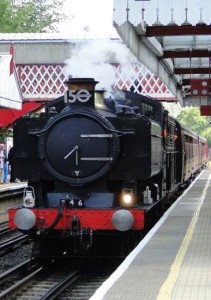
People were being evacuated to the country, where it was safer. Three hundred Jewish children were evacuated to Amersham at this time! How would you feel if you had to leave your home and life as you knew it, with the knowledge that your house could be bombed? You may have had to leave your friends and pets behind, and children may have come without their parents to live up to five years with people who were previously unknown to them. Some families in the Jewish community managed to stay together. Others came alone.
It mustn’t be all doom and gloom. Britain would not be beaten by Jerry. Let’s go and have a jolly good time at the theatre.
Directions to the theatre: (0.1 miles) From the station entrance, turn left under the railway bridge. The old theatre is now the Amersham Auction House, 125 Station Road, HP7 OAH, on the left hand side as you walk downhill.
Amersham Rep Theatre (The Playhouse) – STOP 2
During the war, there was no TV, so people had to entertain themselves. Without the modern technology that we have today people had to find alternative entertainment. Several members of the Jewish community came to this building, today an auction house, which used to be The Amersham Playhouse. They came to this theatre to act and to be entertained. Many plays were produced here, including Rebecca by Daphne De Maurier.
Members of the Amersham Synagogue, remember Dirk Bogarde. One evacuee, Ivor Deitchman, recalled travelling to London with him on the train. Many other well-known actors started their careers at this theatre. Money was scarce in the 1940’s, so sadly it closed down after the war. In order to bring light into people’s lives, just after the war, George Marks, another member of the Jewish community, founded today’s Amersham Playgoers. They meet at the Amersham Community Centre to this very day. George passed away in May 2006 aged 92. He was actively involved with the group for most of that time, directing and appearing in over one hundred plays. Now, unfortunately for some, we are going back to school.
Directions to the school (0.2 miles) From Amersham Auction House, cross to the other side of the road. Walk uphill, under the railway bridge, and continue along Station Road, crossing the road on the corner with Rectory Hill, taking you onto Chesham Road. The school, HP6 5HA, is on the left.
Dr Challoner’s Grammar School – STOP 3
In 1937 Dr Challoner’s had become part of the state system for the first time since its establishment in 1624. During the war, both girls and boys were admitted to this school. Today this building is for boys only. Many pupils of the Amersham Synagogue used to attend here, including Ivor Deitchman, who was in the school’s cricket team. One of his class mates was Chanoch Ehrentreu, who later became head of the United Synagogue’s Beth Din. The head boy of Dr Challoner’s was Maurice Bloch, who qualified as a doctor and worked in London. Dr Bloch belonged to the more orthodox Chesham Jewish Community, part of the Federation Synagogue. Maurice’s older brother was Rev. Sonnie Bloch who sometimes took services at the Amersham Synagogue. David Stamler was another classmate, who went on to become the Head of Carmel College, a Jewish boarding school.
Pupils had to carry their gas masks to school in a brown box on a string. The Government issued them to every citizen and they had to be carried with them by law. The children would have had to practise wearing their masks, as it was feared the Germans were going to release gas and kill people with it. They also practised going to the shelters in the event of an air raid. Bombs did fall over Amersham, and one landed in the playing fields of Dr Challoner’s.
In many schools where children had been evacuated in large numbers, schooldays would have been divided, so that children would have had either a morning or an afternoon at school, because they couldn’t accommodate everybody at the same time. Many Jewish children came from London schools and after a half day at school might well have gone to Jewish and Hebrew lessons in the afternoons, and always on Sundays.
Enough of the education already! Let’s go to the pictures. On the way to the cinema, imagine Sycamore Road in the war years. We would have seen people dressed in what today we call vintage clothing. There wouldn’t have been many, if any, cars because of petrol rationing. Instead, you would have seen cyclists and even one or two horses. Shop fronts would have looked empty for lack of items to sell. Don’t trip over the sandbags whilst window shopping!
Rumour might have spread that the greengrocer has oranges in, so queues of housewives and children could have formed along Chiltern Parade for the rare treat. The long line of shops, on the left-hand side of the street, were built by Sainsburys and opened in 1928. Everyone had to pay the same for their goods. There was no shopping around for the best prices.
Close to the Regent cinema was a Wartime Food Office. It was also very close to the synagogue. This is where ration books were issued to every single adult and child. Every six months people had to be issued with a new book. In that Amersham window were displays of dried milk, concentrated orange juice and the unpopular, disgusting tasting, cod-liver oil!
Directions to the cinema (0.2 miles) From Dr Challoner’s Grammar School follow Chesham Road onto the main high street of Sycamore Road. Continue to the far end until the right-hand side, outside St Michael and All Angels Church, directly opposite Iceland,75 Sycamore Rd, Amersham HP6 5EQ.
REGENT CINEMA (Iceland) – STOP 4
Pack up all your troubles and try to forget there’s a war on by coming to the pictures, join the hundreds of people who worked hard toward the war effort but needed a couple of hours of escapism to help them face their troubles. This was a time for dreaming, romanticising, watching the action on the big screen, or taking your eyes off for a bit of courting. There was a seven-hundred seats cinema here during the war. One little Jewish boy spent hours in that cinema, and the very next day would be re-enacting Western films with local children on Amersham Common.
There was a siren by the Regent Cinema in Sycamore Road that was used to warn of air raids, and after the war it was used to call out the fire brigade. The shelter was built in October 1940 and accommodated fifty people. (Bucks County Archives). When the bombers were approaching Amersham the sirens started up with their eerie wailing, and people would run to the air raid shelters. People had also built shelters in their gardens, and if they didn’t have a shelter they would dive under the table! Some brave souls became ARP (Air Raid Precaution) wardens in this area, a few of them also happened to be Jewish. Raoul Amar was awarded a Long Service Award for his contribution to civil defence in 1967 which started when he was an ARP warden in Little Chalfont during the war.
Directions to the Synagogue: From St Michael and All Angels Church, continue, the short distance, to the corner of Sycamore Road where it meets Woodside Road. Turn the corner outside the row of shops. On the opposite side of the road you can see Amersham Free Church. Look for the wooden arch between the houses. (HP6 6AJ)
SYNAGOGUE SITE STOP 5 – AMERSHAM HEBREW CONGREGATION (otherwise known as Woodside Hall)
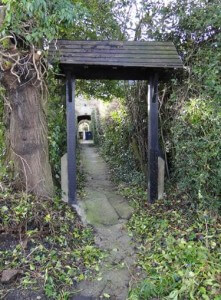
Across the road, where the Free Church now stands, was the bowling green where, Ivan, a Jewish boy, would sneak a look at the bowlers. The bowling green is now in Hervines Park. Between the shops and houses is a wooden archway which was the walkway to the synagogue. The Amersham Hebrew Congregation built the synagogue in 1942. Prior to this, the Jewish evacuees and refugees had met in people’s homes and St Leonard’s Church Hall, Chesham Bois for prayers, cheder (religion school) and socials.
This was not only a synagogue but also a communal hall for the Jewish people living here. The main use was for religious education for one hundred children in the Amersham area. Originally, at the height of the evacuation, there had been three hundred Jewish children.
There was a social club and kosher canteen for Jewish members of the armed forces who were stationed nearby. Each family in the congregation would invite two men to their homes for Shabbat (Sabbath) meals and the Yom Tovim (Holy Days). Kosher meat was bought in London and High Wycombe. How wonderful, in those circumstances, for these Jewish servicemen, whatever their age, to have such a warm welcome into the Jewish community.
Can you imagine what it must be like to be a young person, to be away from your home and your parents, fighting in a war? What would you feel like in these circumstances? Despite all the negative feelings, some younger children who didn’t understand the politics of war enjoyed the excitement of dogfights battles in the sky, collecting shrapnel, playing on crashed planes and generally making the best out of exceptional circumstances.
The rearmost section of the synagogue hall was divided from the main portion, and the latter curtained off when required, which gave accommodation for three separate classes, for the time the children weren’t at school, used on three or four days of each week. On other occasions, including Shabbat, (Sabbath, the day of rest, beginning at sunset on Friday and ending sunset on Saturday) the main body, with the curtains withdrawn, were used as the central place of worship for all the Jewish community in the district. The hall was also available for social functions, and the then Rev, I Rapaport, called it a “war nursery and army hut.” rather than a synagogue.
The grounds of the synagogue were donated by the Hirschfeld family and the Kahan family donated timber. The furniture came from bombed out synagogues in London. There was a canteen in Chesham Bois run by a committee of Jewish ladies. Children could get a good dinner for 4d, and adults for 1/-. How much was one shilling worth? (Answer … 5p.)
During the course of the war there were three reverends serving at this synagogue. Two went on to become rabbis. They also had a chazzan (cantor) with a beautiful tenor voice.
Several barmitzvahs (a coming-of-age in which a thirteen-year-old boy may read from the Torah – Old Testament) took place at this synagogue, during WW2, right here, in Amersham. Food was strictly rationed, so the party afterwards might not match the feast of today. In fact, some did not have a party. Also, when it was dark, no light, not even a chink could be on show for the Germans to see where to drop their bombs. So after the party, you’d have to make your own way home in the blackout with no light to guide you except for the stars. On cloudy nights it could have been as black as when you shut your eyes tight. What’s more, today you probably don’t have to worry about your family and about people that have been left behind under a dictatorship. You don’t live under the fear of air raids. Of course, for Jewish boys becoming men, they may have had a growing awareness of the great danger posed by Hitler invading Britain, and if he did that you knew that your liberty and life would be no more. For a long time it was a genuine threat that Hitler would take control of Britain. If Hitler had succeeded, none of the Jewish people would be here today.
Directions to St John’s Ambulance (0.1 miles)Continue along the pavement all the way down the length of Woodside Road, crossing Chiltern Avenue just opposite the ambulance station. Turn into the road that leads to The Chiltern Pools leisure centre. Opposite to the ancient Barn Hall is the St John Ambulance building on the left at Chichester Row, Amersham, HP6 5AR.
ST JOHN’S AMBULANCE – STOP 6
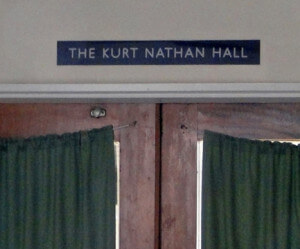
Kurt Nathan, a member of the Amersham Synagogue who lived at Torwood Clifton Road, Chesham Bois set up this branch of the St John’s Ambulance Brigade. There is a room named after him inside the building. Just look through the window by the entrance to see his name prominently displayed above the hall doors. Mr Nathan also served as Cadets Divisional Superintendent. He and his wife, like some other Jewish volunteers, were also Amersham air-raid wardens.
During the war, the volunteers of St John’s would have attended to casualties after bombing raids. They had training sessions in first aid. Ambulances were not allowed to have lights showing because of the blackout which made it very dangerous to drive. Mainly women had to do the driving, first aid, digging people out, and lifting people onto stretchers away from bomb sites. The women did a great deal of the work as most healthy men were away fighting. Between them, the two main first aid charities, St John’s Ambulance and the Red Cross cared for thousands of people on the Home Front.
Directions to King George V Playing Field With the St John Ambulance building on your left continue straight ahead following the grass verge until you enter the playing field.
King George V Playing Field – STOP 7
Do you think this field would have looked the same as it did during the war years? If you said, ‘yes’ – that was the wrong answer! There would have been no swings and playthings, more like land girls and haystacks! Every bit of land would have been utilised for growing food. A bomb landed in this very field.
The woods surrounding Amersham were filled with Prisoner of War camps and military camps. The Home Guard trained locally, complete with broomsticks instead of guns! They also dug trenches, signs of which can still be spotted around the woods and fields today, such as in Rectory Wood.
Despite the horrors of war there was a wonderful Jewish community spirit here and whilst accommodation was often hard to find the local population was often supportive and creative with both the Amersham and Chiltern Rugby Club house and the Chesham Cricket Club pavilion used to house Jewish families during the war. There were cake baking competitions for all the people living in Amersham, and one refugee claims the Jewish ladies won every time! Everyone grew fruit and vegetables and dug for victory. Jams and pickles were made – all were involved with the war effort. Mrs Lissak was prominent in WVS. As well as supporting her husband in the founding of the Amersham branch of St John’s Ambulance, Elsa Nathan founded and chaired a branch of the WIZO (Women’s International Zionist Organisation) in Old Amersham. Mrs Kleiner of Dorset House, Long Park (the mother of Sergeant Harry Kleiner, commemorated on the Chesham Bois War Memorial – see above) and many other women were members of the WVS and knitted balaclavas, gloves, socks and so on which were distributed to the armed forces. Essie Amar, from Little Chalfont, held fundraising events such as Stalls for Warship Week which raised £76 and £425 raised at a flag day for the United Aid to China. After the war she was invited to a garden party at Buckingham Palace in recognition of her work for the National Savings Committee. The vibrant Jewish families did all that they could to help local charitable causes, the war effort, and to keep on smiling through.

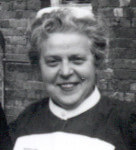 One lady, who kept on smiling, and giving to the town of Amersham, was Sister Katie Krone who worked tirelessly in Amersham Hospital. She helped transform the Old Amersham workhouse into a hospital. She was a German Jewish refugee from Stettin. Her family were all murdered by the Nazis. Yet she did everything she could to help others. Katie worked in the hospital for the rest of her career. She was a strict nursing sister, keeping everything in order, clean and tidy but always very caring.
One lady, who kept on smiling, and giving to the town of Amersham, was Sister Katie Krone who worked tirelessly in Amersham Hospital. She helped transform the Old Amersham workhouse into a hospital. She was a German Jewish refugee from Stettin. Her family were all murdered by the Nazis. Yet she did everything she could to help others. Katie worked in the hospital for the rest of her career. She was a strict nursing sister, keeping everything in order, clean and tidy but always very caring.
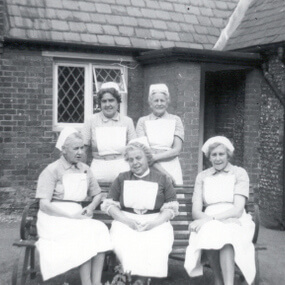
In interview, Katie mentioned a kind rabbi, from WW2 Amersham, who rode a motorcycle and wore a green jacket. It took a long time, and much investigation, to find out who this could be. The answer can be found in our book, The Rabbi in the Green Jacket: Memories of Jewish Buckinghamshire 1939-1945 which contains interviews from the Jewish people of Wartime Buckinghamshire. Their memories provide a fascinating insight into wartime Buckinghamshire life from the unique perspective of those from a Jewish background. Their history, and that of their Buckinghamshire hosts, might otherwise be entirely forgotten.
© Copyright Vivien and Deborah Samson 2015

